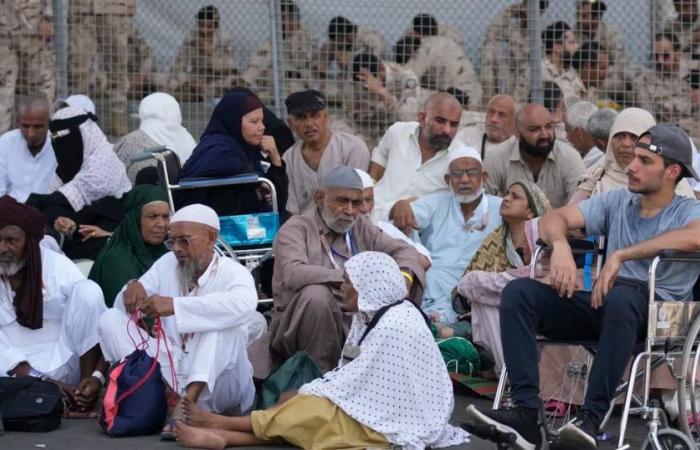The Minister of Health of Saudi Arabia, Fahd al Yalayelreported this Sunday that 1,301 people died during the pilgrimage season to Mecca and the holy places of Islam, mainly due to high temperatures.
Al Yalayel highlighted that 83 percent of those who died had not received official authorization to carry out the pilgrimage and explained that many of them took long walks on foot, under the sun, without any type of protection or rest. Some of them were elderly people who suffered from chronic illnesses, according to the news portal Ajbar24.
The minister explained that the deceased have been identified and the next of kin have been informed, although he warned that the process may take time, since many do not carry any type of identification. The bodies have been buried according to custom in Mecca and a death certificate has been issued.
The Saudi health system provided more than 465,000 specialized services, 141,000 of them to unauthorized pilgrims, and in many cases for heat-related conditions, the minister said in an interview with Saudi television. Al Ijbariya. Many of them remain hospitalized, according to Al Yalayel, who has highlighted the work of health personnel and security forces.
Earlier, Cairo officials had detailed that about half of the dead were Egyptians.. The government, however, announced the deaths of 31 pilgrims due to chronic illnesses during this year’s hajbut did not give an official total count.
However, a government official reported at least 630 more deaths who traveled to Saudi Arabia on visit visas, most registered at the Emergency Complex in the Al-Muaisem neighborhood of Mecca. An Egyptian diplomat confirmed the count and said most of the dead had been buried in Saudi Arabia.
The officials spoke on condition of anonymity because they were not authorized to brief the media.
In its statement, the government said 16 travel agencies had failed to provide adequate services to pilgrims. He added that these agencies illegally facilitated travelers arriving in Saudi Arabia with visas that did not authorize them to reach Mecca.
Those responsible for the companies were reported to the prosecutor’s office for investigations, the government added.
Among the dead, according to the first reports, there were also 165 pilgrims from Indonesia, 98 from India and dozens more from Jordan, Tunisia, Morocco, Algeria and Malaysia., according to The Associated Press count. The death of two American pilgrims was also reported.
The AP could not independently confirm the causes of the deaths. However, some countries, such as Jordan and Tunisia, have attributed them to the sweltering heat.
Associated Press journalists saw pilgrims fainting from the scorching heat during the hajj, especially on the second and third days. Some vomited and collapsed.
The deaths are not unusual in the hajj, which has at times brought together 2 million people in Saudi Arabia for five days of rituals. Deadly stampedes and epidemics have also occurred in the past.
However, this year’s death toll was significantly higher than usual, suggesting exceptional circumstances.
In 2015, a stampede in Mina during the haj killed more than 2,400 pilgrims, the deadliest incident on the pilgrimage, according to an AP count. Saudi Arabia has never acknowledged the total number of deaths. In another incident that year, a crane collapsed at the Grand Mosque in Mecca, killing 111 people.
The second deadliest incident at the hajj was a stampede that killed 1,426 people in 1990.
During this year’s celebrations, daily temperatures were between 46 degrees Celsius (117 degrees Fahrenheit) and 49 degrees Celsius (120 degrees Fahrenheit) in Mecca and at sacred spaces in and around the city, according to the Saudi National Center for Meteorology. . Some people fainted when they tried to participate in a symbolic stoning of the devil.
The hajj, one of the five pillars of Islam, is among the largest religious gatherings in the world. More than 1.83 million Muslims performed the haj in 2024, including more than 1.6 million from 22 countries, and some 222,000 Saudi citizens and residents, according to Saudi haj authorities.
More than 1.83 million Muslims performed the haj in 2024, including more than 1.6 million arrivals from 22 countries, and some 222,000 citizens and residents of Saudi Arabia, according to Saudi haj authorities.
Saudi Arabia has invested billions of dollars in crowd control and security measures for those making the annual five-day pilgrimage, but the sheer volume of participants makes it difficult to ensure their safety.
Climate change could exacerbate the risk even further. A 2019 study by experts at the Massachusetts Institute of Technology concluded that even if the world manages to mitigate the worst effects of climate change, the haj would be celebrated in temperatures that would exceed the “extreme risk threshold” from 2047 to 2052 and from 2079 to 2086. .
Islam uses a lunar calendar, so the haj is celebrated about 11 days earlier each year. By 2029, the hajj will occur in April and in the coming years after that it will fall in winter, when temperatures are milder.
(With information from AP)






